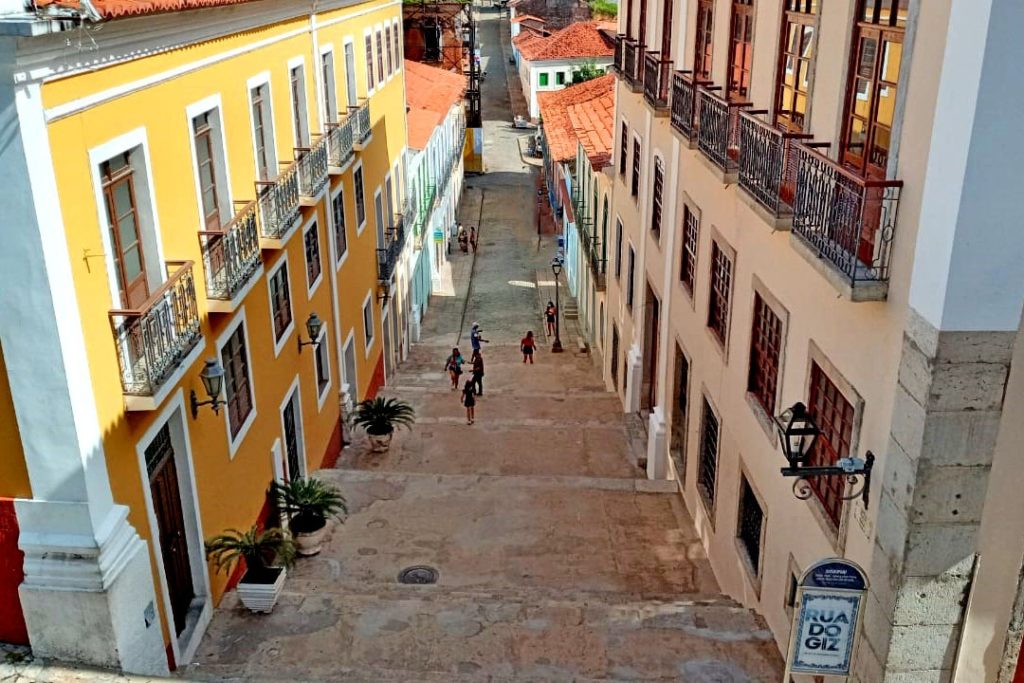Este post também está disponível em:
Português
English

Rua do Giz, which was once the setting for a soap opera, once housed an important economic corridor, and in opposition to this, was also the cradle of the bohemian life of São Luís do Maranhão.
Among the alleys in the historic area of the city, Rua do Giz (or 28 de Julho) is notable for its architectural ensemble and its social importance in the city’s daily life.
Taking up a long stretch of the former Freguesia de Nossa Senhora da Vitória (today the Praia Grande neighbourhood), it began at Largo do Palácio and ended at Rua Nova Cascata.
After the urban reform that filled in the Largo and a stretch of Rua de Nazaré, today the street starts at Nazaré and ends at Rua Jacinto Maia, parallel to the Convento das Mercês.
The set of slopes and staircases was given the name “Giz” in reference to “the steep and slippery clay slope, which hindered traffic, so it received the staircase that corrected its defect”, as researcher Carlos de Lima explains.

Rua do Giz em São Luís do Maranhão
The name “28 July”, according to Domingos Vieira Filho, was due “to Antônio Henriques Leal when he was a council member in 1865”. The denomination is a reference to the date of accession of the Province of Maranhão to the Independence of Brazil in the year 1823.
The Lower Meretricious Zone (ZBM)
Rua do Giz still retains characteristics of the time when, alongside the streets of Palma, Estrela, Saúde, Afonso Pena and the Travessas da Lapa, Feliz and Portinho, it formed the Zona do Baixo Meretrício (ZBM). The set of streets was stigmatised as a space of debauchery, prostitution and naughtiness, going through two distinct moments.
According to Professor Marize Campos, the intention to segregate a space in the capital for prostitution was part of a broader project, which aimed at “the urban sanitation of São Luís, to which moral sanitation interests were linked”. Ordering and civilising the city meant defining a space for pleasure in the urban perimeter.
From the beginning of the 1930s, the meretricious neighbourhood of São Luís became the target of interventions by the public authorities. From September 1931, the Civil Guard began to carry out “day and night giros [inspections] in the houses of prostitution […].
In São Luís, the interferences were, at first, verified in the imposition of limits on the hours of circulation of prostitutes in the territory of the city”.
During this period, the region was defined by its regulars and residents by the glamour of its nightclubs and venues. These regulars were part of the Ludovico elite.

And they were there because the courtesans were well dressed, the salons had good quality music with the best musicians in town, which gave the owners of the establishments status as “madams” of great power and respect.
Houses on Rua do Giz
The second period begins in the 1980s and marks the decline of the ZBM. The madams became old prostitutes, full of children and mostly in great financial difficulties.
The glamorous nightclubs today are nothing more than poorly maintained mansions transformed into tenements to house large families.
The colonial houses on this stretch of Rua do Giz contrast with some of the most beautiful and imposing mansions on the street, home to illustrious and important businesses in the city.

Among them, the Solar da Baronesa de Anajatuba, where the Maranhão Historical and Artistic Heritage Institute (IPHAN) now operates, and the house of musician Lilah Lisboa, home of the Maranhão Music School.

The first, known as the “Trojan Horse”, is one of the tallest buildings in the area and has four storeys, ending in eaves, with a symmetrical façade facing west.
The second building, on the other hand, has three floors made up of stone walls from the colonial period and decorative elements in the Art Noveau style from the early 20th century, brought to São Luís by the Italian architect Gaspar Iconazone. Its façade is set back from the surrounding buildings, surrounded by a wall made of circular modules.
There were also shops and banks on the street, such as Machado Cavalcanti & Cia, which sold imported food products such as olive oil, codfish, soft drinks and chocolates. Or Batista Nunes & Cia, which sold offal, stevedores and cigarettes.
The banking houses were represented, among others, by the Banco Comercial do Maranhão, the Banco do Maranhão, inaugurated in 1855, and the famous Banco Comercial. There were also credit centres, such as Ferreira & Cia, located in building number 5, which offered commission and consignment services, and Viana & Santos, located at number 9.
Today the street is home to restaurants, hotels, museums and cultural centres, such as the Domingos Vieira Filho Popular Culture Centre, the Casa da FÉsta and the Maranhão Natural History and Archaeology Research Centre. It will also soon house the Museum of the Portuguese Language – Maranhão.
Tourism and Travel Guide to São Luís do Maranhão and the Northeast



















